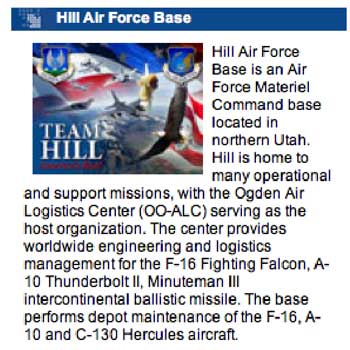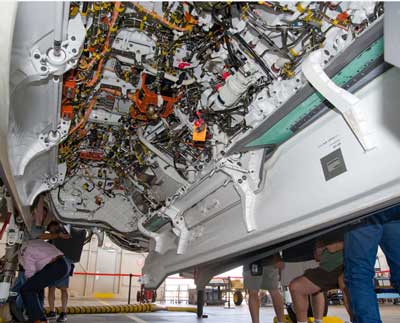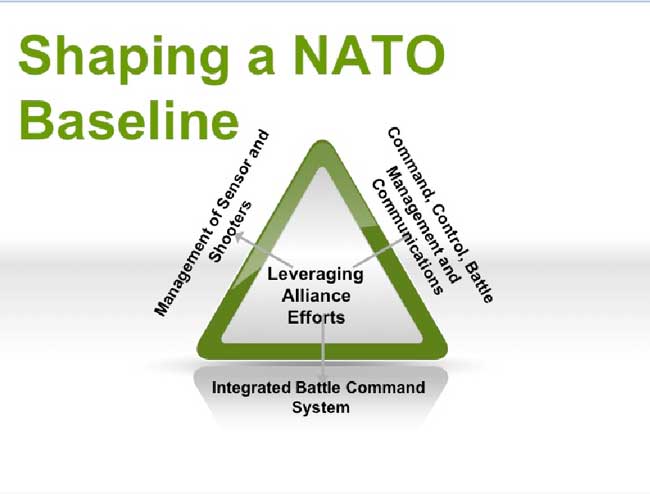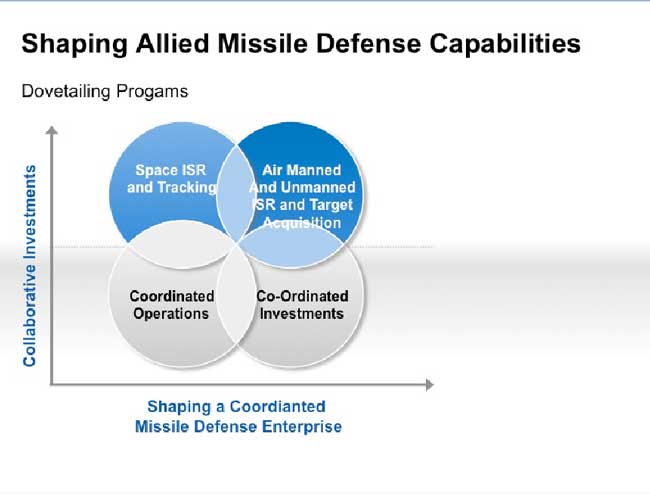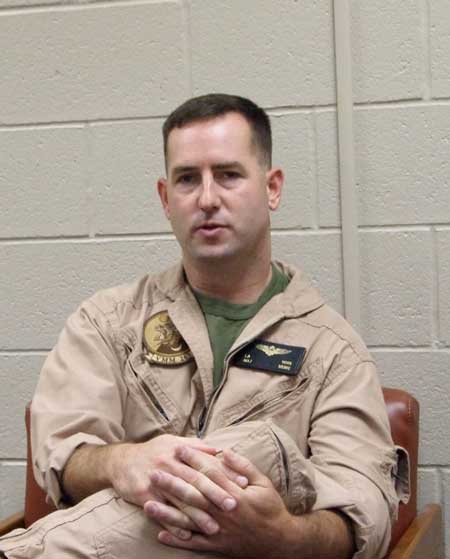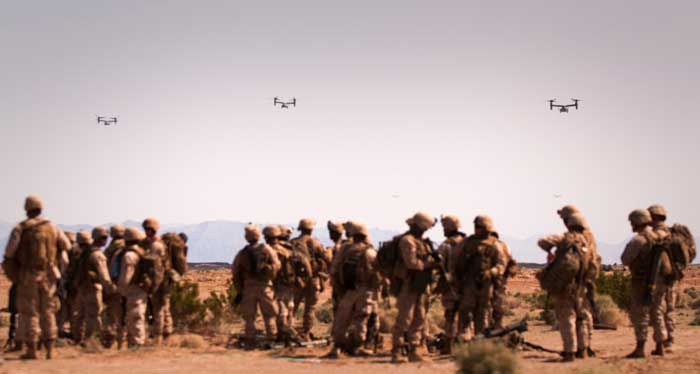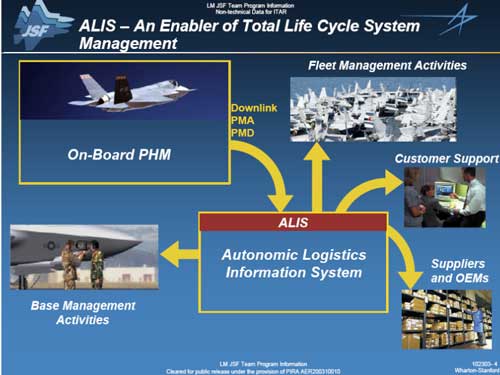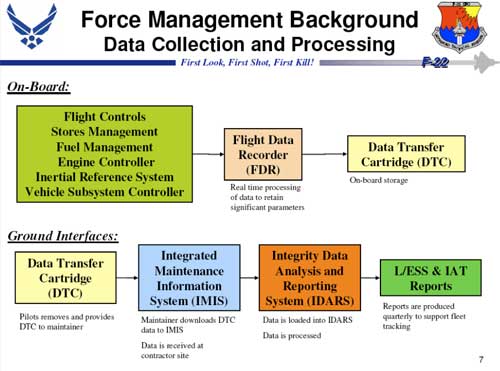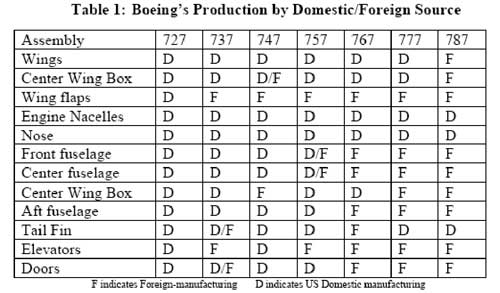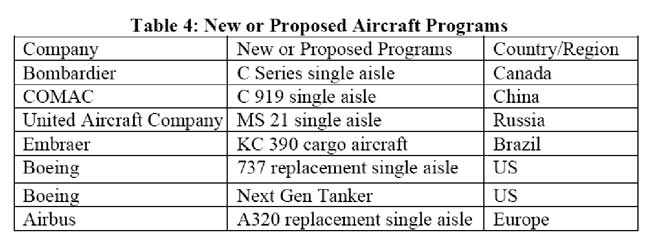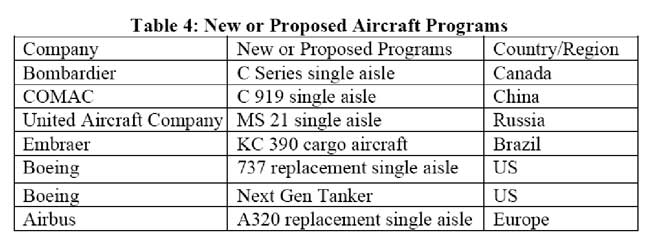Vice Admiral Joseph W. Dyer, U.S. Navy (Ret.) on the Future of Military Robotics and Awaiting New Concepts of Operations
11/05/2010 – Second Line of Defense recently sat down with Vice Admiral Joe Dyer (U.S. Navy, Ret.), Chief Operating Officer at iRobot Corporation, to discuss the evolution of robotics and its relationship to evolving military capabilities and concepts of operations. Before becoming COO, Vice Admiral Dyer served as president of iRobot’s government and industrial robots division for seven years. His naval career includes positions as commander of the Naval Air Systems Command, naval aviation’s chief engineer, commander of the Naval Air Warfare Center, Aircraft Division and F/A-18 program manager. Earlier in his career, he was the navy’s chief test pilot. Vice Admiral Dyer is therefore well positioned to discuss the impact of robotics on future USN and USMC joint operations, which was one theme of the discussion.
SLD: How should we think about robotics in the bigger global competition?
Vice Admiral Dyer: Let me offer you the research question that asks: What’s America’s next big thing? We did well with agriculture, we did well with automobiles, we did well with aviation, and we did well with information technology. So, what’s our next big thing?
There are two strong candidates –biogenetics and robotics. I’m hard pressed to come up with another one that pops during my lifetime.
Let me offer you the research question that asks: What’s America’s next big thing? We did well with agriculture, we did well with automobiles, we did well with aviation, and we did well with information technology. So, what’s our next big thing? There are two strong candidates –biogenetics and robotics.
The economic engine that carries us forward, that provides a foundation for all things defense or all things employment must be part of our economic calculus.
SLD: Is DOD investment in robotics technology part of the equation driving an American advantage?
Vice Admiral Dyer: The concept that DOD technology leads the way to the marketplace is a model of much of the XXth century, and certainly up through the early 1980’s. Beginning in the 1990’s, not so much… In the 1990’s, especially in the information technology, DOD found itself following rather than leading. Robotics may well be a return to the model where DOD investment is delivering breakthrough capability for the Department, and at the same time engendering a new commercial technology.
SLD: How would you characterize the current state of development and the next stages of evolution of the robotics enterprise?
Vice Admiral Dyer: There is huge excitement in the robotics community right now about the development and deployment of autonomous systems. Simultaneous localization and mapping are concurrent developments. We call it, in shorthand, the ability to arbitrate and navigate. What’s at stake is the ability to go from today’s teleoperation, where there is a one-to-one relationship between operator and robot, to more autonomous operation with smarter robots. This transition is from “driving the robot” to “supervising multiple robots.”
SLD: Rather, an extension of the person?
Vice Admiral Dyer: Yes, the “distance from danger” that robots provide has done an important job of contributing to survivability in today’s conflict. And it is as transformational a story as I think you can find anywhere. When the iRobot PackBot went into in Afghanistan in late 2002, the challenge was to provide a simple extension of the soldier while undertaking cave exploration. Prior, the tactics and doctrine called for 19-year-old soldier with a 12-foot stick and a rope around his waist. The rope was there to get him out if he got hurt, without having to send somebody else in.
So you went from that to a virtual presence via a robot, literally at a point in time you can put your finger on. In a town that loves to talk about transformation, it’s hard to find great examples of it; but, this is clearly a transformation story.
The “distance from danger” that robots provide has done an important job of contributing to survivability in today’s conflict. And it is as transformational a story as I think you can find anywhere. When the iRobot PackBot went into in Afghanistan in late 2002, the challenge was to provide a simple extension of the soldier while undertaking cave exploration. Prior, the tactics and doctrine called for 19-year-old soldier with a 12-foot stick and a rope around his waist. The rope was there to get him out if he got hurt, without having to send somebody else in. So you went from that to a virtual presence via a robot, literally at a point in time you can put your finger on. (…) this is clearly a transformation story.
To tie that back to autonomy, robots today are where fighter aircraft were when I started flying 35 years ago. Back then, it took 80 percent of your time to attend to the airframe, the engine, and a navigation problem. And you had only 20 percent of your time left to apply to the mission. Today, that’s almost exactly reversed. Now, the airframe, engine, and navigation problems pretty well take care of themselves. By the way, if the aircraft needs any help, the machine will ask you for it. And you’ve got 80 percent of your time available to dedicate to the mission: robots today are akin to fighters of 35 years ago.
SLD: Could you describe the next phase of evolution?
Vice Admiral Dyer: There are very, very exciting things that are happening right now, literally right now. iRobot is inserting the initial autonomous capabilities – out of the lab, into the field and in theatre. The initial capabilities are much simpler than people think. Right now, you’ve got to drive the robot every step of the way. One of the first things we’re doing is to look at what we might call “cruise control”, which basically tells a robot to maintain its vector until the operator tells it to do something else. That alone brings a tremendous reduction in operator overhead, operator loading and duty cycle.
SLD: So you can get situational awareness without having to have human oversight, so to speak?
Vice Admiral Dyer: Well, it’s even simpler than that. It’s that if I’ve got to drive the robot half a mile before I can go to work on the IED. I don’t want to have to attend to it every step of the way. Another of today’s big problems is — if a robot loses comms today, you have to hike out and get the robot. Not a popular thing; you wouldn’t have sent the robot, if you wanted to be out there. So another of the capabilities we are delivering is a retro-traverse. If the robot loses communications, it retraces its path until communications are restored. These initial autonomous functions are the start of a “hockey stick” growth curve in autonomous technology.
Another of today’s big problems is — if a robot loses comms today, you have to hike out and get the robot. Not a popular thing; you wouldn’t have sent the robot, if you wanted to be out there. So another of the capabilities we are delivering is a retro-traverse. If the robot loses communications, it retraces its path until communications are restored. These initial autonomous functions are the start of a “hockey stick” growth curve in autonomous technology.
Let me talk a little bit in general and then a little bit more specifically on this marriage of technology and how profoundly it’s going to affect tactics and doctrine. Today, we have robots that are an extension of self. With a robot, I can virtually go downrange, I can see, I can manipulate, I can hear, I can talk, I can sense on a broad range of sensors. But still, the robot is an extension of the operator.
SLD: We’re reducing risk to yourself, and able to engage in a wider range of dangerous environments.
Vice Admiral Dyer: Exactly. Robots are putting distance between my fragile body and things that can hurt me. One of the beautiful things about robots, by the way, is that THEY ARE FEARLESS! The next stage beyond robot as an extension of self and a virtual presence is a robot as wingman, or, battle buddy, or teammate. And this big leap is going on at places like iRobot today, and in labs like the TARDEC, Army Research Lab, and SPAWAR out in San Diego. In this future case, you give the robot a task to autonomously perform as part of the combat team. And, oh by the way, you can communicate with the robot via voice and gesture; you don’t have to joystick it.
SLD: What is enabling this transformation?
Vice Admiral Dyer: The ideas of how to do that go back literally to iRobot’s founder Professor Rodney Brooks’ work at Stanford 30 years ago, but the processing speed just wasn’t available to make it practicable. Affordable processing, computers light enough and inexpensive enough to put into a piece of mobile equipment, just were not available. Fast forward to today and you can see that Moore’s Law has been really good to many things, but it has never been better than it is to robotics. So, after today’s robot teleoperation, the next phase is this ability to give a robot a task and have it execute the task. We’ll see initial capability deployed within the next three to five years.
SLD: How do you see the next phase of robotics as part of re-shaping concepts of operations?
At iRobot, we have a vision of integrated Unmanned Air Vehicles (UAV’s), Unmanned Ground Vehicles (UAV’s) and Unmanned Underwater Vehicles (UUV’s). A way I like to think about that is to envision a littoral combat ship that shows up off the coast of some bad guy’s country. Let’s take a look at how different that will be compared to the way we do it today:
Let’s consider UUVs, which I think are one of the most exciting developmental areas that are underway. UUV’s are, by the way, the area where autonomy is needed more than anywhere else. Why? Well, while you’ve good radio frequency bandwidth when you’re airborne, you have very little bandwidth when communicating with UUVs. Underwater, you’re limited to acoustic modems for un-tethered operations. An acoustic modem is slower than your first dial-up PC connection to the web. But as you start to introduce more autonomy, you start to tremendously increase the utility of unmanned underwater systems. Autonomy is important for the future of all robots, but critically important for UUVs. That is what iRobot is building at our unmanned underwater systems group in Raleigh-Durham, North Carolina. But let’s continue with this Navy ship showing up with a Navy/Marine Corps team on an adversary’s littoral during the next decade. The preparation for entering that battle space will be tremendously improved in many ways by unmanned systems.
SLD: Could you describe the impact?
Vice Admiral Dyer: First, let’s talk about airborne mine countermeasures. Mine countermeasures are challenging to execute. Because mines are at-sea-IEDs, they are challenging asymmetric weapons capable of “area denial.”
SLD: Wouldn’t it be great if we took an Army lesson learned, and applied it to the maritime mission ahead of being massively challenged at sea by mine warfare?
Vice Admiral Dyer: You’re absolutely right. I worry that the Navy has not taken full notice of the IED threat. Our Navy’s interest in and focus on maritime IEDs (mines) is episodic and our attention has always been short. Unmanned systems will offer new capabilities at sea, just as unmanned ground robots have for ground forces.
SLD: How will you deliver it into the battlespace?
Vice Admiral Dyer: I believe UUV’s offer great potential but there are challenges. The prime challenges for UUVs are range and power,area coverage. UUVs have the disadvantages of being relatively slow and of limited search duration. So you can’t efficiently transit them; you have to deliver them to the area of interest. At iRobot, we’re coming at this problem with our Ranger program, which we’re funding atop some basic work sponsored by the Office of Naval Research. We are designing a Ranger UUV that’s “A-size.” “A-size” means it fits into a sonobouy launcher. And there are literally thousands of tubes out there on multiple patrol and tacair platforms. Marry the capability to air-launch with swarm capability and you cut out the transit time, greatly reduce the power requirement and introduce UUVs directly into the area of interest.
Using swarm techniques, which DARPA has funded iRobot and others to develop; you start to see the operations research numbers get much, much better. This isn’t something that’s awaiting better batteries and more power; it’s awaiting further development of a new concept.
SLD: One of the things we have been looking at is the impact on the amphib of the new technologies, Osprey, F-35B and CH-53K, on making this ship and its capability a key battle manager center with the LCS and the kind of robotics you are describing. Would carrying UUV’s be a weapons bay issue for an F-35, because it’s stealth?
Vice Admiral Dyer: You’d need to tuck the sonobuoy launcher into the bomb bay to protect the F-35’s radar cross section just as you do with air-to-air weapons. Let me tell you why I think it’s a tacair mission, a tactical aircraft mission, and not an attack sub, helicopter or patrol aircraft mission. Attack subs, are expensive assets to stick into dangerous (mined) areas. They want and need standoff distance. When standing-off, you suffer UUV transit time, and now you are expending a lot of energy before you’re in the search area. Additionally, upcoming underwater, counter-air launched weapons are going to make mine fields dangerous places for slow movers – helos and low altitude patrol aircraft. A set of mines that can operate against air as well as naval assets will dramatically change the counter-mine calculus. To deliver a small swarm of UUV’s directly to the area of interest, you need to get in and get out quickly.
SLD: You are creating a whole new approach linked with other new assets, which will become available to the USMC-USN team?
Vice Admiral Dyer: Yes. We see important linkage between the evolution of the robotics capabilities and concepts of operations. With the new UUVs, we will do airborne mine countermeasures before the amphibs go in; in the more distant future, we will be able to do ASW with UUV’s. We will have UUVs taking UGVs into the surf zone, and transporting them ashore. And you’re going to be launching UAVs all at the same time.
We see important linkage between the evolution of the robotics capabilities and concepts of operations. With the new UUVs, we will do airborne mine countermeasures before the amphibs go in; in the more distant future, we will be able to do ASW with UUV’s. We will have UUVs taking UGVs into the surf zone, and transporting them ashore. And you’re going to be launching UAVs all at the same time.
So this Navy/Marine Corps team, as they go into the area of interest, has cleared mines and acquired both God’s view from above and the up-close, personal view from UGVs. This will yield an unprecedented level of situational awareness before anyone ever goes ashore.
SLD: Another way to look at it is the difference between classic combat aircraft and what we’re doing with the F-35. In the classic aircraft, you’ve got a forward looking infrared sequential look. With the 35, you’re taking a 360-degree swathe, so you’re looking at the entire battle space. So what you’re describing is a 360-degree application from an unmanned point of view. There is tremendous synergy. Basically, you’re extending the ability to bring the Marine Corps and Navy assets to bear on this or the Air Force assets for that matter. You’re talking about moving the bubble ashore.
Vice Admiral Dyer: Right. You’ve got it. Let’s talk about western Iraq for a minute. If you go back to the build-up for the war in Iraq, early 2000’s — God bless the special ops guys, because we had them between a rock and a hard spot. We inserted them with serious geopolitical/POW risk. Today, you can supplement and ease their mission with unmanned ground systems in addition to UAV’s. Not unrelated, we’ve done some good work looking at standoff parafoil insertions of robots. This may be one of the best ways to get a robot into a dangerous area. We’re talking about robots that have multispectral sensors; that have acoustic capabilities, both listening and talking. We’re talking about being able to do unmanned, remote laser designation….
SLD: Could you talk about the iRobot Seaglider?
Vice Admiral Dyer: Seaglider is a “sailplane”, but one that operates under water. It’s slow, only does about one to two knots. But it literally can cross the Pacific. There were four Seaglider UUVs working down in the Gulf of Mexico with the oil spill. Now, you’re talking about affordable persistence surveillance with a Seaglider. It’s a better and more affordable way to regain some of the important capabilities we let-go after the Cold War ended. At iRobot, we’re investing a lot of time figuring out how to combine UUVs, UGVs and UAVs to give warfighters better technical advantages and far better survivability.
Among Others, the Australians Will Have New Tankers Prior to the USAF Credit: http://www.cae.com/en





